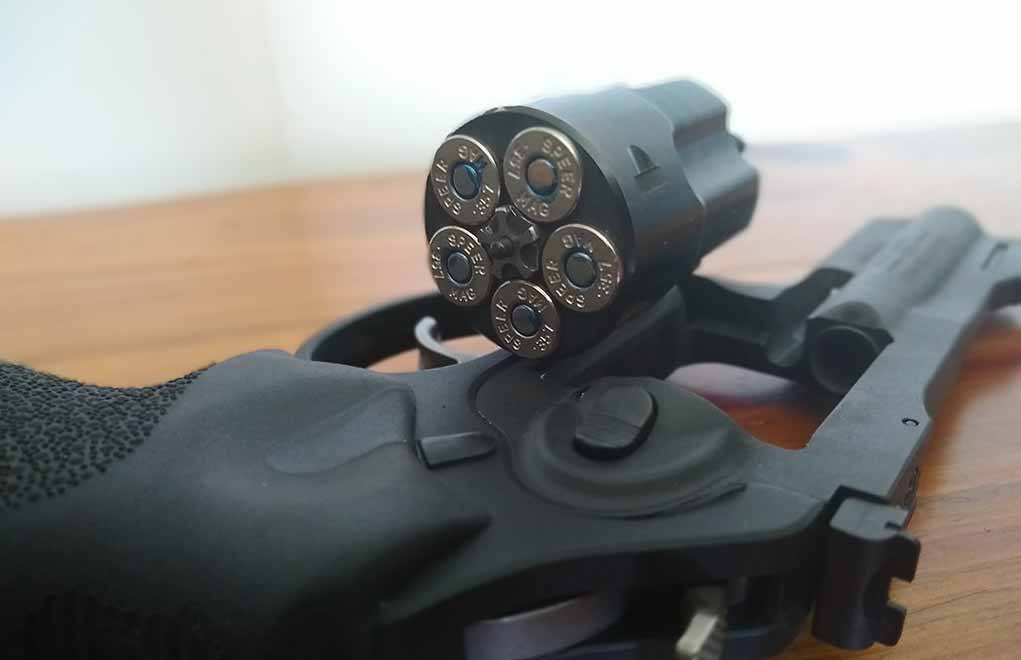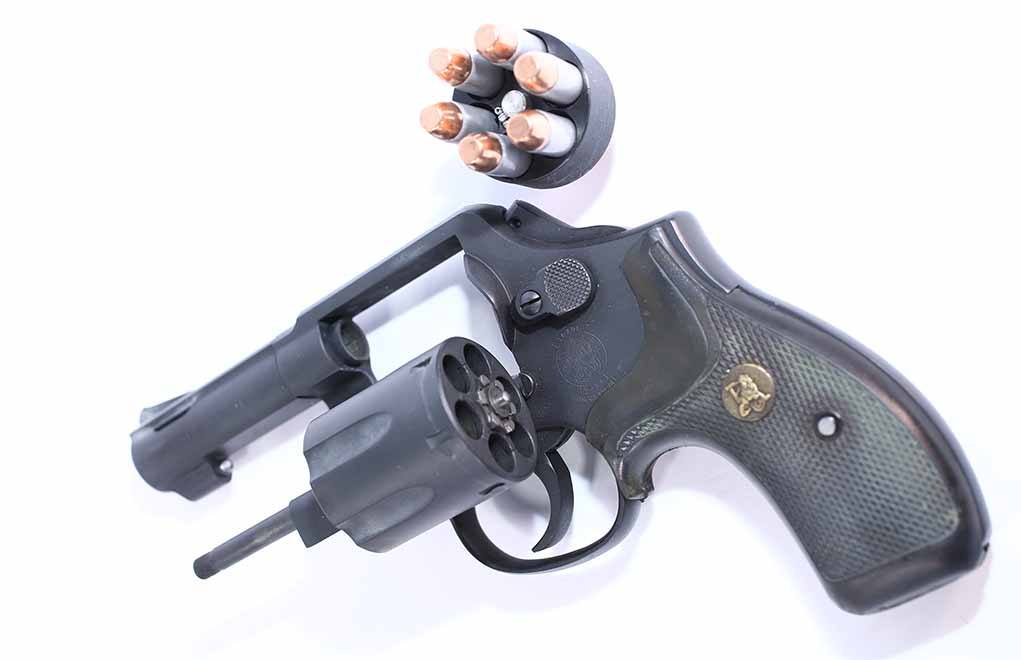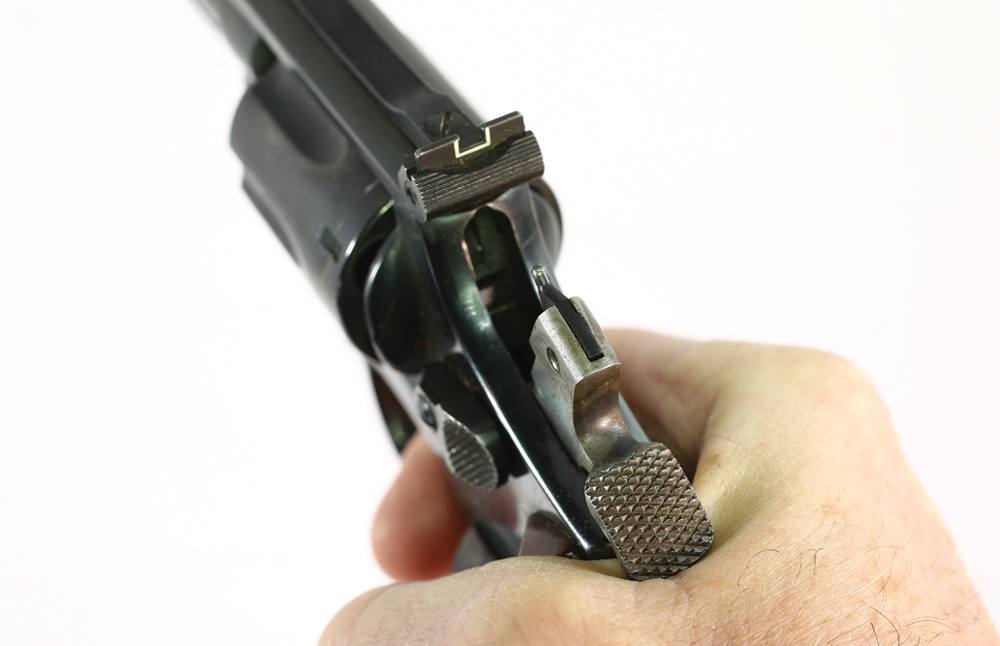https://gundigest.com/gear-ammo/ammunition/357-magnum-the-pros-and-cons-for-self-defense?By Elwood Shelton -April 8, 2021
We weigh the pros and cons of the .357 Magnum as a defensive cartridge to see if the time-tested option is the right fit for you.What Are Some Of The .357's Pros And Cons:
Pros* Proven Self-Defense Cartridge
* Simple Manual of Arms In Its Guns
* Manageable For Most
Cons* Difficult Double-Action Trigger
* Shorter Barrels Notably Reduce Velocity
* Limited Capacity
Perfect middle ground. In a sense that sums up the .357 Magnum. On the one hand, the souped-up .38 special offers exceptional velocities in most of its loads and plenty of punch when it reaches the target. On the other, with practice and the right handgun, nearly any shooter can become proficient with the granddaddy magnum—something that can’t be said for most other cartridges of this class, which at best are cranky.

Is the .357 Magnum a good fit for you?
Twin virtues shining through, it’s little wonder the .357 Magnum flourished in the 20th Century, perhaps the most popular handgun of that era. Now, it’s overshadowed by pistol cartridges, given the greater shooting world has flocked in that direction in the past 40 years. However, changing tastes have done little to tarnish what the iconic revolver magnum brings to the table.
Yes, even in a world awash with polymer, high-capacity heaters the .357 Magnum remains a viable choice for self-defense. Is it for everyone? No, but what cartridge is? We'll take a look at the time-tested cartridge's pros outweigh its cons and if it's right for you.
Brief History Of The .357 MagnumBefore tallying pluses and minuses of the .357 Magnum, it's worth a moment to consider its roots. The cartridge was the brainchild of Elmer Keith and Phil Sharpe, both of whom were tinkering with hot-rodding the .38 Special in the 1930s. Though, it was Sharpe and Major Douglas B. Wesson who were responsible for bringing the magnum to market; Keith fell away from the cartridge with his interest shifting to developing what would become the .44 Magnum.
Essentially, the .357 is a .38 Special with 1/8-inch added to the case length. A small improvement with immense results. The larger case capacity vastly improves velocity over its parent case. An example. A .38 loaded the 158-grain Hornady Custom sends a bullet flying at around 800 fps from a standard service-length revolver barrel, whereas a .357 loaded with 158-grain Hornady Custom sends it screaming 1,250 fps from the same setup. That's a 34-percent improvement in velocity!
That muscle had a lot of appeal when it was released in 1935 in Smith & Wesson's “Registered Magnums”. Everyday shooters appreciated the inherent accuracy of the cartridge, particularly out of longer-barreled revolvers. And law enforcement welcomed an option with the ability to penetrate common barriers, such as car doors—something the .38 Special struggled accomplishing. Rumrunners and mobile bank robbers of the day made officers conscious of this deficiency.

The .357 Magnum is simple a .38 Special cartridge that has been lengthened by 1/8 of an inch.
While it perhaps never exceeded the .38 Special in law enforcement use, the .357 Magnum was still among the most profuse options utilized by the long-arm of the law. And it's fairly safe to say, had not a wave of semi-auto pistols washed over the shooting world in the 1980s, the .357 Magnum would likely be the most popular handgun cartridge today.
.357 Magnum Pros And ConsTalk to five different shooters about any given cartridge or gun, you’ll likely get five different opinions and a load of particulars to boot. Opining upon the .357 Magnum is no different. There’s plenty more nuance to the cartridge than the litany of six pros and cons we’ve put together here—as any true .357 aficionados no doubt would be more than happy to tell you. But pertaining to self-defense in general, we believe these considerations are among the most important when weighing if the cartridge and the guns chambered for it are a proper fit for you.
ProsProven Self-Defense CartridgeUsed and studied extensively, the .357 Magnum has, again and again, demonstrated itself a superior self-defense cartridge. Is it the cock-of-the-walk option touted in the once-popular “stopping power” studies, able to neutralize a threat in one-shot 80-plus percent of the time? Given those survey results are shaky at best and useless at worst, we’ll leave that to the gun forums to hash out. However, the cartridge has acquitted itself well in the hands of law enforcement over the years and has one of the widest selections of ammunition capable of passing the FBI penetration tests. For the average armed citizen, the .357 Magnum has more than enough punch to neutralize a threat in most circumstances.
Simple Manual of ArmsGiven the majority of guns chambered for the .357 Magnum are revolvers, armed citizens enjoy one of the most robust handgun systems ever devised. Most times, solving troubles is as simple as pulling the trigger. This makes for a much simpler manual of arms as compared to semi-auto pistols, which require plenty of drilling to efficiently address stoppages. This isn’t to say revolvers are malfunction-free. They aren’t. What’s more, trouble-shooting one that's jammed is involved compared to the tap-rack-bang of semis. Usually, something like a pulled bullet requires a gunsmith to right. That said, these catastrophic stoppages are rare to the point most shooters will never confront one.
If you want something a bit more utilitarian, then my Bearcoat-coated M-65, with a 3-inch barrel will deliver more of the .357 Magnum velocity you might desire. It’s a definite working tool, and one I’ve packed many times in the last 20-plus years.

Need to solve a malfunction with a .357 Magnum revolver? Just pull the trigger again.
Manageable For MostThere are a lot of gray areas here, given the variability of cartridge-gun combinations. But for the most part, a great swath of guns chambered in .357 Magnum are accessible to the better part of the shooting world. Outside of the .327 Federal Magnum, this isn’t a claim most other magnums can make—certainly not the .41 Magnum or .44 Magnum. The medium- and large-frame revolvers in which the .357 is chambered keep it well mannered, with more material and weight balancing against the cartridge’s recoil. Additionally, the medium bullet diameter also plays a role. This doesn’t mean every shooter can expect to step behind the business end of a .357 and proceed to shoot the lights out. But the learning curve is less steep than most magnum cartridges.
ConsDouble-Action TriggerThe other edge to the aforementioned simple manual of arms is the feature that makes it elementary—the double-action trigger. Handy as the system is, it’s not the easiest to master. Generally speaking, DA triggers are long and heavy and require a proper technique to consistently stay on target. This is why for most novices a revolver—unless it's your only option—isn’t the ideal first concealed-carry gun. Expect to practice and continue practicing to get this facet down pat.
Shorter Barrels Notable Reduce VelocityThe old saw about snubbie .357 Magnum revolvers is they're no more powerful than .38 Special shooting +P ammunition. A vast overstatement anyway you cut it, there is a kernel of truth in the myth. The .357 is particularly sensitive to barrel length, perhaps more so than many handgun cartridges and has diminished returns in an abbreviated bore. Yes, you’ll still have a better velocity profile out of a 2-inch barreled .357 Magnum revolver than a .38 Special, but it's still fairly off the mark of what shooters expect out of a magnum. Not to mention, all that excess powder burning outside the bore of snubbie .357's produces enough muzzle flash to light a stogy.
This is the author’s grip, high up on the frame. When the hammer comes back, it brushes the web of the author’s hand because his grip is so high.

One of the stickiest points on the .357 Magnum, it comes in double-action revolvers, which generally have long and heavy trigger pulls.
Limited CapacityThis isn’t purely confined to the .357 Magnum, but any revolver cartridge. In most cases, expect a revolver to hold 6 rounds, 5 if it’s tailored to concealed carry. Not a ton. Add in a little matter of revolver reloads being much more involved than semi-auto pistols—taxing fine-motor skills under stress—capacity becomes a sticky point for many. Should it be? That depends on your standpoint. FBI data puts the typical officer-involved shootings at around 5-feet and involving two to three rounds fired. Given that, yes a .357 revolver should prove more than enough. But if you value redundancy in your life-saving tools, it looks like a razor-thin margin of error.
Parting ShotThe .357 Magnum is among the most iconic American handgun cartridges and still treasured today. Despite losing favor in the past few decades, it isn’t going anywhere. The granddaddy magnum has too much going for it, particularly as a defensive tool. That said, determining if it’s the right option for you takes some consideration, not only of the cartridge itself but your skills as a shooter. Take the time to mull these factors, add in range time with make/models you’re interested in, and it should become clear if the .357 is a fit.